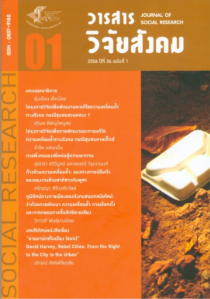โครงการวิจัยเพื่อพัฒนาและแก้ไขความเหลื่อมล้ำทางสังคม กรณีชุมชนสวนหลวง 1
Main Article Content
บทคัดย่อ
การวิจัยนี้มีวัตถุประสงค์เพื่อวิเคราะห์สภาพปัญหา และความต้องการของชุมชนตามกระบวนการมีส่วนร่วม และร่วมมือกันจัดการปัญหาเพื่อให้ชุมชนได้พัฒนาอย่างยั่งยืน และลดความเหลื่อมล้ำ ของสังคม 6 ประเด็น คือ 1) การเข้าถึงระบบการศึกษาและการพัฒนาเยาวชน 2) การพัฒนาด้านกายภาพของชุมชน 3) การแก้ไขปัญหาความยากจนและสร้างความเข้มแข็งแก่ชุมชน 4) การปฏิบัติที่ไม่เป็นธรรมโดยอำนาจรัฐ 5) การเข้าถึงทรัพยากรของรัฐ และ 6) การมีส่วนร่วมในการแสดงความคิดเห็นและการตอบสนองของภาครัฐต่อความคิดเห็นของชุมชน โดยเป็นการวิจัยเชิงคุณภาพ ซึ่งได้จากข้อมูลพื้นฐานของชุมชน การลงพื้นที่เพื่อสร้างความสัมพันธ์ การสัมภาษณ์เจาะลึกคณะกรรมการชุมชน และการจัดประชุมกลุ่มจากตัวแทนประชาชนในชุมชนสวนหลวง 1 จำนวน 45 คน ด้วยเทคนิคบันไดคุณภาพชีวิต (bamboo ladder) และกระบวนการมีส่วนร่วม (Appreciation Influence Control หรือ AIC) ที่เปิดโอกาสให้กลุ่มตัวอย่างร่วมกันระดมความคิดเห็นเกี่ยวกับสภาพปัญหา ความต้องการของชุมชนและแนวทางการพัฒนาอย่างเป็นกระบวนการ ตลอดจนทบทวนสภาพชุมชน จากอดีตจนถึงปัจจุบัน
ผลการวิจัย พบว่า ชุมชนสวนหลวง 1 เขตบางคอแหลม เป็นชุมชนแออัดขนาดใหญ่ ที่อยู่ใจกลางกรุงเทพมหานคร ชาวชุมชนส่วนใหญ่เป็นชาวมุสลิม ตั้งบ้านเรือนอยู่อย่างหนาแน่น มีคลองสวนหลวง 1 อยู่ภายในชุมชนซึ่งยังต้องการการบำรุงรักษา เนื่องจากตืน้ เขิน ทางเดินเท้าภายในชุมชนสะอาดและเป็นระเบียบ ประชาชนในชุมชนได้รับการศึกษาในระดับต่ำถึงปานกลาง อาชีพส่วนใหญ่ คือ ค้าขาย รับจ้าง เป็นต้น ประชาชนส่วนหนึ่งพยายามหาอาชีพเสริมเพื่อเพิ่มรายได้ด้วยการประกอบหัตถกรรมในครัวเรือนอาทิ การประดิษฐ์ของใช้ การทำดอกไม้ประดิษฐ์ เป็นต้น คณะกรรมการชุมชนมีความสามัคคีกลมเกลียว และสามารถรวมชาวชุมชนให้แน่นแฟ้นได้ซึ่งพบว่าเมื่อมีการจัดงานจะมีประชาชนในชุมชนออกมาร่วมแรงร่วมใจช่วยกันอย่างแข็งขัน
อย่างไรก็ตาม ประชาชนในชุมชนมีความหวังว่าภาครัฐจะเข้ามาช่วยด้านความปลอดภัยในชีวิตและทรัพย์สินภายในชุมชน ระบบป้องกันอัคคีภัย การศึกษา สาธารณสุข สิ่งแวดล้อม และการดูแลผู้สูงอายุ เนื่องจากปัจจุบันจำนวนผู้สูงอายุเพิ่มมากขึ้น ผลสรุปที่ได้จากการประชุมกลุ่มเพื่อดำเนินการตามโครงการพัฒนากิจกรรม (เงินทุนต้นกล้า) คือ การติดตั้ง ไฟฟ้ า รอบชุมชน บริเวณราวกันตกตามทางเดินตลอดทั้ง ชุมชน เป็ นจำนวนเสาไฟฟ้า 39 ต้น แล้วเสร็จเดือนมีนาคม 2555 สร้างความพอใจแก่ประชาชนในชุมชนเป็นอย่างยิ่ง
Development of Strategic Plan for Social Inequality: A Case Study of Suanlaung 1 Community
This research was to analyze problems and needs of communities through the involvement process and cooperation in handling problems for sustainable development in communities and to reduce social inequality in six issues, i.e. accessing educational system and youth development, developing the community physicality, solving poverty and strengthening communities, unfair treating by the state power, accessing the state resources and involvement in expressing opinion and response of the state to the community opinion.
This was a qualitative research conducted by means of the basic data of the community, fieldwork approach to build relation, indepth interview with the community committee members and organizing the group meeting of 45 representatives from Suan Luang 1 Community by employing the techniques of bamboo ladder and Appreciation Influence Control (AIC) which included the process of giving samples opportunity to brainstorm about problems and needs of the community and development approaches and to reflect the community conditions in the past until today.
The result revealed that Suan Luang 1 Community, Bang Khor Laem District was a large-size slum located in the center of Bangkok. The majority of the members were Muslims. The households were congested with SuanLuang 1 Canal in the community area. The canal needed maintenance because it became shallow. The walkways were clean and orderly. People in the community could access to only a low to middle education level. Most of them were trader, employee and so on. Some of them sought pastime career to increase their income through the household handicraft such as utensil making, artificial flowers and so on. The community committee harmonized and could solidify people in the community witnessed when organizing function, people strongly collaborated. Nevertheless, unlawful things were still found in their community such as drugs and gambling.
However, people in the community expected that the public sectors would help them with life and property security in their community, fire protection system, education, public health, environment and elder care because these days the number of the elder was increasing. Synopsis of the group meeting to follow the activity development project (Seedling Funds) was installing electricity around the community, along walkway railings in the community, totaling 39 electricity posts, which was complete in March 2012 and strongly created satisfaction among people in the community.
Article Details
1) บทความนี้เป็นลิขสิทธิ์ของสถาบันวิจัยสังคม จุฬาลงกรณ์มหาวิทยาลัย แต่ความคิดเห็นและเนื้อหาเป็นของผู้แต่ง
2) ทัศนะและความคิดเห็นที่ปรากฏในบทความในวารสารวิจัยสังคมและปริทัศน์ สถาบันวิจัยสังคม จุฬาลงกรณ์มหาวิทยาลัย ถือเป็นความรับผิดชอบของผู้แต่งบทความนั้น และไม่ถือเป็นทัศนะและความรับผิดชอบของกองบรรณาธิการวารสารวิจัยสังคมและปริทัศน์ สถาบันวิจัยสังคม จุฬาลงกรณ์มหาวิทยาลัย กองบรรณาธิการไม่สงวนสิทธิ์ในการคัดลอก แต่ให้ระบุถึงการอ้างอิง


